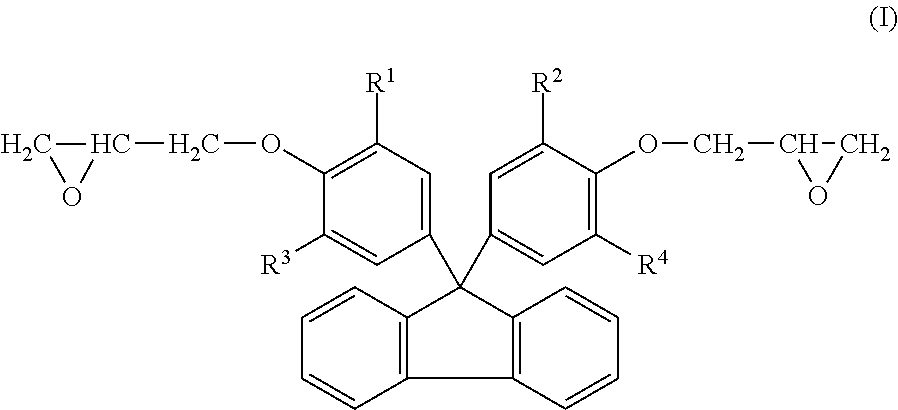Photosensitive resin composition and applications of the same
a technology of photosensitive resin and composition, applied in the field of photosensitive resin composition, can solve the problems of deterioration of the adhesion of the black matrix, high cost, complex process, etc., and achieve the effect of superior ageing stability
- Summary
- Abstract
- Description
- Claims
- Application Information
AI Technical Summary
Benefits of technology
Problems solved by technology
Method used
Image
Examples
synthesis example 1
[0139]A 500 ml four-necked flask was added with a fluorene epoxy compound (ESF-300 manufactured by Nippon Steel Chemical Co., epoxy equivalent: 231, 100 parts by weight), acrylic acid (30 parts by weight), benzyl triethylammonium chloride (0.3 part by weight), 2,6-di-t-butyl-p-cresol (0.1 part by weight), and propylene glycol monomethyl ether acetate (130 parts by weight) at a controlled feeding rate of 25 parts by weight / min in a continuous manner. A reaction was conducted at a temperature ranging from 100° C. to 110° C. for a period of 15 hours to obtain a yellowish transparent mixture having a solid concentration of 50 wt %.
[0140]The yellowish transparent mixture (100 parts by weight) was dissolved in ethylene glycol monoethyl ether acetate (25 parts by weight) while added with tetrahydrophthalic anhydride (6 parts by weight) and benzophenone tetracarboxylic dianhydride (13 parts by weight). A reaction was conducted by heating at a temperature ranging from 110° C. to 115° C. for ...
synthesis example 2
[0141]A 500 ml four-necked flask was added with a fluorene epoxy compound (ESF-300 manufactured by Nippon Steel Chemical Co., epoxy equivalent: 231, 100 parts by weight), acrylic acid (30 parts by weight), benzyl triethylammonium chloride (0.3 part by weight), 2,6-di-t-butyl-p-cresol (0.1 part by weight), and propylene glycol monomethyl ether acetate (130 parts by weight) at a controlled feeding rate of 25 parts by weight / min in a continuous manner. A reaction was conducted at a temperature ranging from 100° C. to 110° C. for a period of 15 hours to obtain a yellowish transparent mixture having a solid concentration of 50 wt %.
[0142]The yellowish transparent mixture (100 parts by weight) was dissolved in ethylene glycol monoethyl ether acetate (25 parts by weight) while added with benzophenone tetracarboxylic dianhydride (13 parts by weight). A reaction was conducted by heating at a temperature ranging from 90° C. to 95° C. for a period of 2 hours. Tetrahydrophthalic anhydride (6 pa...
synthesis example 3
[0143]An epoxy compound (NC-3000 manufactured by Nippon Kayaku Co. Ltd., epoxy equivalent: 288, 400 parts by weight), acrylic acid (102 parts by weight), p-methoxyphenol (0.3 part by weight), triphenyl phosphine (5 parts by weight), and propylene glycol monomethyl ether acetate (264 parts by weight) were reacted in a reactor at a temperature of 95° C. for a period of 9 hours to obtain an intermediate product having an acid value of 2.2 mgKOH / g. Tetrahydrophthalic anhydride (151 parts by weight) was then added. A further reaction was conducted at a temperature of 95° C. for a period of 4 hours. An unsaturated-group-containing resin (A-1-3) was obtained, which had an acid value of 102 mgKOH / g and a weight average molecular weight of 3,200.
Preparation of Other Alkali-Soluble Resin (A-2)
PUM
| Property | Measurement | Unit |
|---|---|---|
| temperature | aaaaa | aaaaa |
| temperature | aaaaa | aaaaa |
| temperature | aaaaa | aaaaa |
Abstract
Description
Claims
Application Information
 Login to View More
Login to View More - R&D
- Intellectual Property
- Life Sciences
- Materials
- Tech Scout
- Unparalleled Data Quality
- Higher Quality Content
- 60% Fewer Hallucinations
Browse by: Latest US Patents, China's latest patents, Technical Efficacy Thesaurus, Application Domain, Technology Topic, Popular Technical Reports.
© 2025 PatSnap. All rights reserved.Legal|Privacy policy|Modern Slavery Act Transparency Statement|Sitemap|About US| Contact US: help@patsnap.com



